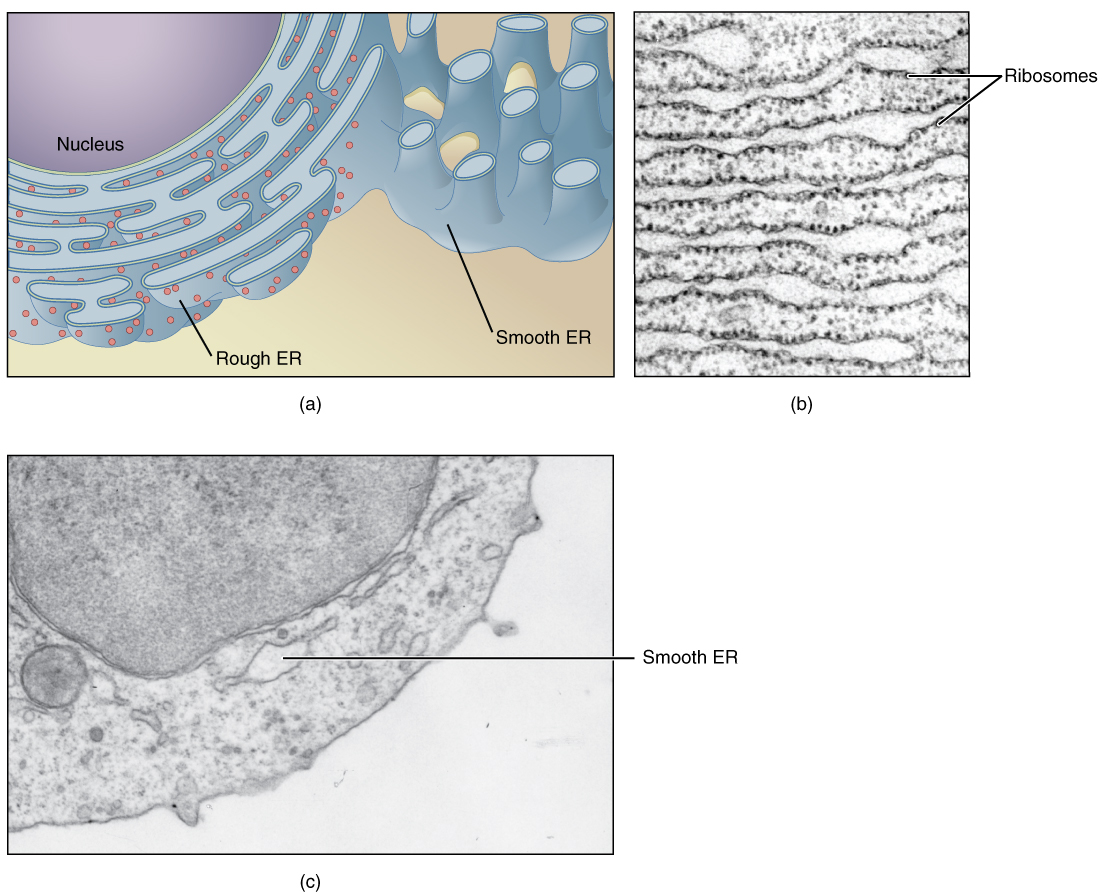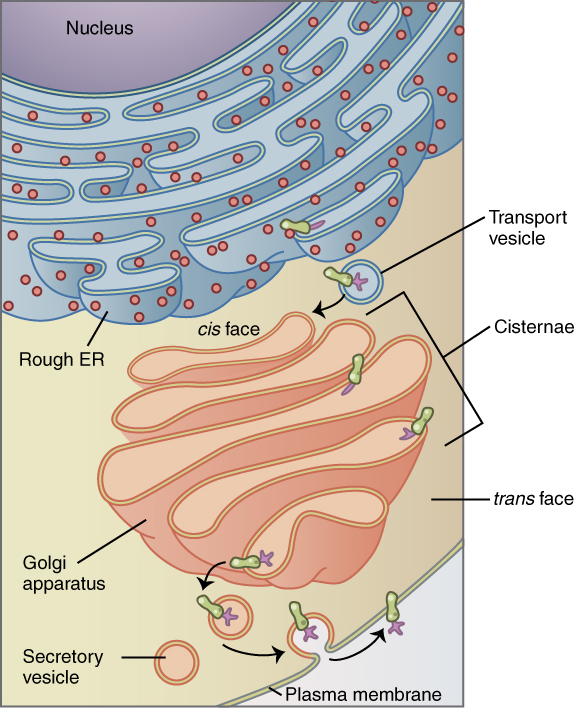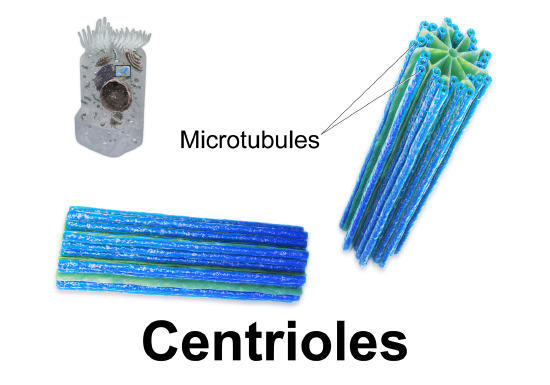What Is The Most Important Organelle In An Animal Cell
5.half dozen: Jail cell Organelles
- Page ID
- 16744
Effigy \(\PageIndex{1}\) represents an of import construction in living cells. It is a component of a ribosome, the cell construction where proteins are synthesized. Large ribosomal subunit (50S) of Haloarcula marismortui, facing the 30S subunit. The ribosomal proteins are shown in blueish, the rRNA in ochre (a shade of dark-brown and xanthous), the active site in ruby. All living cells contain ribosomes, whether they are prokaryotic or eukaryotic cells. Yet, just eukaryotic cells also contain a nucleus and several other types of organelles.

An organelle is a construction within the cytoplasm of a eukaryotic cell that is enclosed within a membrane and performs a specific chore. Organelles are involved in many vital cell functions. Organelles in brute cells include the nucleus, mitochondria, endoplasmic reticulum, Golgi apparatus, vesicles, and vacuoles. Ribosomes are not enclosed inside a membrane but are still commonly referred to as organelles in eukaryotic cells.
The Nucleus
The nucleus is the largest organelle in a eukaryotic cell and is considered to be the cell'south control center. Information technology contains well-nigh of the cell'southward DNA, which makes upward chromosomes and is encoded with the genetic instructions for making proteins. The role of the nucleus is to regulate gene expression, including decision-making which proteins the cell makes. In addition to Deoxyribonucleic acid, the nucleus contains a thick liquid called nucleoplasm that is similar in limerick to the cytosol found in the cytoplasm outside the nucleus (Figure \(\PageIndex{two}\)). Most eukaryotic cells contain just a unmarried nucleus, but some types of cells, such as red blood cells, contain no nucleus. A few other types of cells, such as muscle cells, comprise multiple nuclei.

As yous tin can see from the model in Effigy \(\PageIndex{2}\), the membrane enclosing the nucleus is called the nuclear envelope. This is actually a double membrane that encloses the entire organelle and isolates its contents from the cellular cytoplasm. Tiny holes, called nuclear pores, allow large molecules to pass through the nuclear envelope with the help of special proteins. Big proteins and RNA molecules must be able to pass through the nuclear envelope so proteins can be synthesized in the cytoplasm and the genetic material can be maintained inside the nucleus. The nucleolus shown in the model below is mainly involved in the assembly of ribosomes. After being produced in the nucleolus, ribosomes are exported to the cytoplasm where they are involved in the synthesis of proteins.
Mitochondria
The mitochondrion (plural, mitochondria) is an organelle that makes free energy bachelor to the jail cell (Figure \(\PageIndex{3}\)). This is why mitochondria are sometimes referred to equally the power plants of the cell. They utilize energy from organic compounds such as glucose to make molecules of ATP (adenosine triphosphate), an free energy-carrying molecule that is used almost universally inside cells for energy.
Scientists think that mitochondria were in one case free-living organisms considering they contain their own DNA. They conjecture that ancient prokaryotes infected (or were engulfed by) larger prokaryotic cells, and the two organisms evolved a symbiotic relationship that benefited both of them. The larger cells provided the smaller prokaryotes with a place to alive. In return, the larger cells got extra energy from the smaller prokaryotes. Eventually, the smaller prokaryotes became permanent guests of the larger cells, equally organelles inside them. This theory is chosen the endosymbiotic theory, and information technology is widely accepted by biologists today

Mitochondrial Compartments
The double membrane nature of the mitochondria results in five distinct compartments, each with an important role in cellular respiration. These compartments are:
- the outer mitochondrial membrane,
- the intermembrane space (the infinite betwixt the outer and inner membranes),
- the inner mitochondrial membrane,
- the cristae (formed by infoldings of the inner membrane), and
- the matrix (infinite within the inner membrane).
Endoplasmic Reticulum
The endoplasmic reticulum (ER) (plural, reticuli) is a network of phospholipid membranes that form hollow tubes, flattened sheets, and round sacs. These flattened, hollow folds and sacs are called cisternae. The ER has two major functions:
- Send: Molecules, such every bit proteins, tin can movement from place to place inside the ER, much similar on an intracellular highway.
- Synthesis: Ribosomes that are attached to the ER, similar to unattached ribosomes, make proteins. Lipids are also produced in the ER.
At that place are two types of endoplasmic reticulum, crude endoplasmic reticulum (RER) and smooth endoplasmic reticulum (SER):
- Rough endoplasmic reticulum is studded with ribosomes, which gives it a "crude" appearance. These ribosomes make proteins that are then transported from the ER in pocket-sized sacs chosen transport vesicles. The transport vesicles pinch off the ends of the ER. The crude endoplasmic reticulum works with the Golgi apparatus to motion new proteins to their proper destinations in the cell. The membrane of the RER is continuous with the outer layer of the nuclear envelope.
- Smooth endoplasmic reticulum does not have whatsoever ribosomes attached to information technology, and then it has a smooth appearance. SER has many unlike functions, some of which include lipid synthesis, calcium ion storage, and drug detoxification. The shine endoplasmic reticulum is constitute in both animal and plant cells and information technology serves dissimilar functions in each. The SER is made upwards of tubules and vesicles that branch out to form a network. In some cells, there are dilated areas like the sacs of RER. Smooth endoplasmic reticulum and RER form an interconnected network.

Golgi Apparatus
The Golgi apparatus (Figure \(\PageIndex{v}\)) is a large organelle that processes proteins and prepares them for use both inside and outside the jail cell. It was identified in 1898 by the Italian md Camillo Golgi. The Golgi appliance modifies, sorts, and packages dissimilar substances for secretion out of the jail cell, or for use within the cell. The Golgi apparatus is establish shut to the nucleus of the cell where it modifies proteins that take been delivered in ship vesicles from the Rough Endoplasmic Reticulum. It is also involved in the send of lipids around the cell. Pieces of the Golgi membrane pinch off to form vesicles that send molecules around the prison cell. The Golgi apparatus can be thought of as similar to a post office; information technology packages and labels "items" and then sends them to different parts of the cell. The Golgi apparatus tends to exist larger and more numerous in cells that synthesize and secrete large quantities of materials; for case, the plasma B cells and the antibiotic-secreting cells of the immune arrangement accept prominent Golgi complexes.
The Golgi appliance manipulates products from the Rough Endoplasmic Reticulum (ER) and also produces new organelles chosen lysosomes. Proteins and other products of the ER are sent to the Golgi apparatus, which organizes, modifies, packages, and tags them. Some of these products are transported to other areas of the cell and some are exported from the prison cell through exocytosis. Enzymatic proteins are packaged as new lysosomes.

The stack of cisternae has four functional regions: the cis-Golgi network, medial-Golgi, endo-Golgi, and trans-Golgi network. Vesicles from the ER fuse with the network and subsequently progress through the stack from the cis- to the trans-Golgi network, where they are packaged and sent to their destination. Each cisterna includes special Golgi enzymes which modify or help to modify proteins that travel through it. Proteins may be modified by the add-on of a saccharide group (glycosylation) or phosphate grouping (phosphorylation). These modifications may form a point sequence on the protein, which determines the final destination of the protein. For case, the add-on of mannose-half-dozen-phosphate signals the protein for lysosomes.
Vesicles and Vacuoles
Both vesicles and vacuoles are sac-like organelles that shop and send materials in the cell. Vesicles are much smaller than vacuoles and have a diverseness of functions. The vesicles that compression off from the membranes of the ER and Golgi apparatus store and transport protein and lipid molecules. You can run into an instance of this type of transport vesicle in the figure above. Some vesicles are used as chambers for biochemical reactions. Other vesicles include:
- Lysosomes, which use enzymes to break down strange matter and dead cells.
- Peroxisomes, which utilize oxygen to break down poisons.
- Ship vesicles, transport contents between organelle besides as between cell outside and interior.
Centrioles
Centrioles are organelles involved in prison cell division. The function of centrioles is to help organize the chromosomes before jail cell sectionalisation occurs so that each daughter prison cell has the correct number of chromosomes later the jail cell divides. Centrioles are found only in fauna cells and are located near the nucleus. Each centriole is made mainly of a protein named tubulin. The centriole is cylindrical in shape and consists of many microtubules, as shown in the model pictured below.

Ribosomes
Ribosomes are small structures where proteins are made. Although they are not enclosed within a membrane, they are oftentimes considered organelles. Each ribosome is formed of 2 subunits, similar the one pictured at the acme of this section. Both subunits consist of proteins and RNA. RNA from the nucleus carries the genetic code, copied from Dna, which remains in the nucleus. At the ribosome, the genetic code in RNA is used to assemble and join together amino acids to make proteins. Ribosomes can be plant alone or in groups within the cytoplasm as well every bit on the RER.
Review
- Ascertain organelle.
- Describe the structure and function of the nucleus.
- Explicate how the nucleus, ribosomes, rough endoplasmic reticulum, and Golgi appliance work together to make and send proteins.
- Why are mitochondria referred to as the ability plants of the cell?
- What roles are played by vesicles and vacuoles?
- Why exercise all cells need ribosomes, even prokaryotic cells that lack a nucleus and other cell organelles?
- Explain endosymbiotic theory as it relates to mitochondria. What is one piece of evidence that supports this theory?
- Lysosomes and peroxisomes are types of:
- A. Organelles
- B. Vesicles
- C. Vacuoles
- D. Both A and B
- Which of the following organelles fits best with each description of function? Choose simply one organelle for each answer: Golgi apparatus, centrioles, nucleolus, nucleus, rough endoplasmic reticulum
- a. Contains the genetic instructions for the production of proteins
- b. Organizes chromosomes before cell partition
- c. Provides a framework for ribosomes
- d. Packages and labels proteins
- due east. Assembles ribosomes
- Truthful or False. All eukaryotic cells have a nucleus.
- Truthful or Simulated. The outer surface of the nucleus of a eukaryotic cell is not completely solid.
Explore More
Source: https://bio.libretexts.org/Bookshelves/Human_Biology/Book%3A_Human_Biology_(Wakim_and_Grewal)/05%3A_Cells/5.06%3A_Cell_Organelles
Posted by: kernsurvis.blogspot.com

0 Response to "What Is The Most Important Organelle In An Animal Cell"
Post a Comment